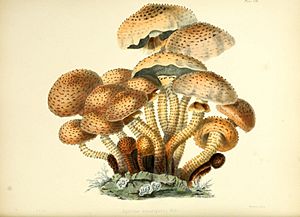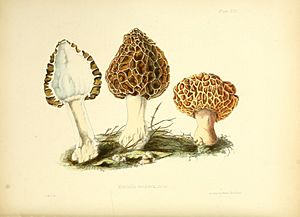Anna Maria Hussey facts for kids
Quick facts for kids
Anna Maria Hussey
|
|
|---|---|
| Born |
Anna Maria Reed
5 June 1805 Leckhampstead, Buckinghamshire
|
| Died | 26 August 1853 (aged 48) |
| Nationality | British |
| Known for | mycologist, scientific illustrator |
| Spouse(s) | Thomas John Hussey |
Anna Maria Hussey (born June 5, 1805, died August 26, 1853) was a talented British scientist, writer, and artist. She was especially known for studying fungi, like mushrooms. She drew many detailed pictures of them.
Contents
Growing Up and Family
Anna Maria Reed was born in Leckhampstead, Buckinghamshire, England. She was one of seven children. Her father, Rev. John Theodore Archibald Reed, was a church leader. He probably encouraged her interest in science at home. Their house had many books, as her father collected Bibles.
Anna's sisters, Henrietta and Frances, helped her become interested in plants and art. At first, Anna was very curious about rocks and Earth's history.
In 1831, when she was 26, Anna married Rev. Dr. Thomas John Hussey. He was also a scientist and an astronomer. They had six children, but only two lived to be adults.
Anna was a strong-willed person. She loved her scientific work more than her duties as a clergyman's wife. She sometimes felt annoyed by parish duties.
Anna wrote many letters to her friend and mentor, Reverend M. J. Berkley. He was a leading expert on fungi. These letters tell us a lot about her daily life and work. Berkeley helped Anna identify fungi, and she sent him many samples. She also knew other important scientists of her time.
Anna also wrote stories for magazines, but these were usually published without her name. This was common for women writers back then.
Discovering and Drawing Fungi
Anna Maria Hussey was very interested in nature. She even knew Charles Darwin, who lived nearby. Her brother, George Varenne Reed, taught Darwin's sons.
Anna and her younger sister, Frances Reed, became experts in fungi. They sent many samples and letters to Rev. Miles Joseph Berkeley, the top fungi expert of their time.
Anna's way of studying fungi was more artistic than purely scientific. She and her sister painted many detailed watercolor pictures of the fungi they found.
In 1847, some of Anna's drawings were used in a book called A treatise on the esculent funguses of England. However, her name was not mentioned in the book.
Illustrations of British Mycology
Around the same time, Anna published her own big and expensive book. It was called Illustrations of British Mycology. This book had 90 colorful pictures of fungi that she or her sister had collected and drawn. It also included her descriptions, personal stories, and thoughts about fungi.
Illustrations of British Mycology was not just a list of fungi. It was a collection of Anna's experiences and knowledge about them. She hoped her book would inspire new mushroom fans, especially young people. She even gave tips on how to find and care for fungi samples.
Anna wrote in her book: "A basket is in the first place needful, and if the student should leave home without one, a profusion of lovely and rare objects will be certain to strew his path..." She explained that if you don't have a basket, your fungi samples might get squashed!
A second volume of her book, with 50 more colorful pictures, was published after she passed away in 1855. Both volumes were praised for being both scientifically correct and beautifully artistic.
Berkeley, the famous fungi expert, even named a group of fungi Husseia after Anna. He said she deserved this honor. Another type of fungi, Cortinarius reediae, was named after her sister, Frances Reed.
Today, the fungi samples Anna and Frances sent to Berkeley are kept at the Royal Botanic Gardens, Kew.
See Also
 In Spanish: Anna Maria Hussey para niños
In Spanish: Anna Maria Hussey para niños



